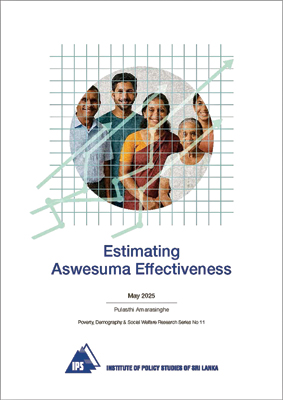While Sri Lanka slowly recovers from its largest economic crisis so far, social protection programs are central to the country’s growth.
The crisis has put a large set of households in or near poverty, with households reeling from losses in income and price hikes.
Social protection is not a new topic for Sri Lanka; however, existing social protection programs at the onset of the economic crisis in 2022, were unable to provide the necessary relief for many low-income families.
 With limited Government funding, these programs had difficulties in expanding, and According to the World Bank’s estimate from 2023, poverty rose to 25% in 2022, from 11.3% in 2019.
With limited Government funding, these programs had difficulties in expanding, and According to the World Bank’s estimate from 2023, poverty rose to 25% in 2022, from 11.3% in 2019.
This increase in poverty signalled a widespread need for improved social protection mechanisms, and in response, the Government of Sri Lanka (GOSL) introduced Aswesuma as a temporary measure to replace the existing Samurdhi program. Aswesuma aims to more accurately identify and assist the most vulnerable households through targeted cash transfers, supporting their pathway out of vulnerability.
The program employs a multidimensional approach to assess the eligibility of applicants for cash transfers using 22 selected indicators across six dimensions: education, health, economic status, houses, family demographics, and assets.
Beneficiaries receive varying monthly cash transfers for six months up to three years, depending on the severity of their poverty status, with the most deprived households across the evaluation criteria receiving larger cash transfers for the maximum duration.
IPS’ latest study titled “Estimating the Effectiveness of Aswesuma: Targeting and Welfare Outcomes in Post-Crisis Sri Lanka,” by IPS Research Fellow Dr. Pulasthi Amarasinghe examines the Aswesuma scheme and its eligibility criteria in identifying poor households and in having an impact on key household welfare impacts. Moreover, suggestions on improving selection criteria are considered following simulations of impact under additional eligibility criteria.
The study develops a robust analytical framework to simulate the effects of Aswesuma cash transfers on household welfare across different eligibility scenarios. It also provides insights on improving the program’s targeting effectiveness by comparing with the multi-dimensional vulnerabilities faced by Aswesuma eligible households with those who received Samurdhi.
The results enable decision-makers to evaluate the possibility of utilising joint or weighted criteria of 22 indicators used in selecting eligible candidates and to identify the necessary changes to move people along the poverty evaluations set forth by the programme criteria.
The addition of other factors affecting key welfare outcomes highlights the importance of including climate change and disaster preparedness as a subset of eligibility criteria.
Thus, in evaluating the effectiveness of the Aswesuma program, our latest publication looks at the specific objectives of:
1. Assessing the effectiveness of the multidimensional criteria of current Aswesuma to identify households relative to its predecessor Samurdhi Programme.
2. Estimating the suitability of Aswesuma indicators in determining the effects on key outcomes related to household welfare.
3. Analysing the impact of the proposed criteria and transfers on welfare outcomes
4. Examining program transformation suggested to improve targeting and better outcomes.
The current improvements to Aswesuma require enhancing its ability to target individuals in chronic poverty (when individuals or households experience a state of deprivation over many years and, at times, pass it on to future generations) and transient poverty (short-term losses in income or expenditure despite having sufficient resources, in the long run, to stay above the poverty line (Duclos et al., 2078)).
The current indicators of the Aswesuma program, which are used to calculate the deprivation score, focus primarily on chronic poverty.









